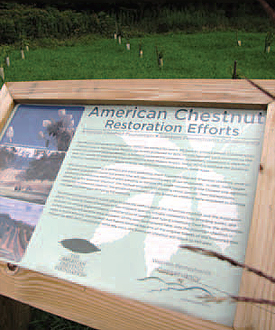Efforts to reestablish American chestnut
tree highlighted at Bear Run

Interpretive sign at the Bear Run chestnut tree demonstration area helps visitors understand the efforts to restore this tree species.
Once described as the most common tree in Pennsylvania, the American chestnut provided a bountiful supply of nuts for Native Americans as well as wildlife including deer, elk, bear, turkey and grouse. Later, European settlers relied on the chestnut tree for its wood, which was a perfect resource for a growing country—easily worked by hand tools, yet strong, light and very resistant to rot. The trees could grow to 10 feet in diameter and more than 100 feet tall, facilitating large wood harvests from relatively small geographic areas.
Around 1900, a fungal blight that was introduced on imported Asian chestnut trees strangled out chestnut forests from Maine to Georgia. By 1940, the American chestnut was virtually gone, except for sprouts from the remaining roots.
To highlight an effort to help restore the American chestnut as a forest tree, WPC worked with The American Chestnut Foundation to establish a demonstration chestnut orchard at Bear Run Nature Reserve in 2008. Chestnuts of different species and hybrid back-crosses were planted in the field next to the lower parking lot of the Barn at Fallingwater. An interpretive sign at the orchard tells the story of the American chestnut, from life to death to rebirth.